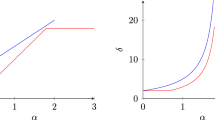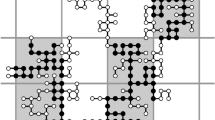Abstract
In high dimensional percolation at parameter \(p < p_c\), the one-arm probability \(\pi _p(n)\) is known to decay exponentially on scale \((p_c - p)^{-1/2}\). We show upper and lower bounds on the same exponential scale for the ratio \(\pi _p(n) / \pi _{p_c}(n)\), establishing a form of a hypothesis of scaling theory. As part of our study, we provide sharp estimates (with matching upper and lower bounds) for several quantities of interest at the critical probability \(p_c\). These include the tail behavior of volumes of, and chemical distances within, spanning clusters, along with the scaling of the two-point function at “mesoscopic distance” from the boundary of half-spaces. As a corollary, we obtain the tightness of the number of spanning clusters of a diameter n box on scale \(n^{d-6}\); this result complements a lower bound of Aizenman (Nucl Phys B 485(3):551–582, 1997).






Similar content being viewed by others
Data Availability
No data was generated in the course of the research described in this manuscript.
Notes
Here we use Aizenman’s [1] definition of “spanning cluster”; other natural definitions of this term exist.
The letter “E” in the abbreviation “EREG” refers to “expectation”. Compare our definition to that of regularity appearing in [30, Section 4].
The letter “S” in the abbreviation “SREG” stands for “shell”. The regularity condition is restricted to a shell to allow us to decouple portions of the cluster.
References
Aizenman, M.: On the number of incipient spanning clusters. Nucl. Phys. B 485(3), 551–582 (1997)
Aizenman, M., Barsky, D.J.: Sharpness of the phase transition in percolation models. Commun. Math. Phys. 108(3), 489–526 (1987)
Aizenman, M., Burchard, A.: Hölder regularity and dimension bounds for random curves. Duke Math. J. 99(3), 419–453 (1999)
Aizenman, M., Newman, C.M.: Tree graph inequalities and critical behavior in percolation models. J. Stat. Phys. 36(1–2), 107–143 (1984)
Barsky, D.J., Aizenman, M.: Percolation critical exponents under the triangle condition. Ann. Probab. 1520–1536 (1991)
Ben Arous, G., Cabezas, M., Fribergh, A.: Scaling limit for the ant in high-dimensional labyrinths. Commun. Pure Appl. Math. 72(4), 669–763 (2019)
Borgs, C., Chayes, J.T., Kesten, H., Spencer, J.: Uniform boundedness of critical crossing probabilities implies hyperscaling. Random Struct. Algorithms 15(3–4), 368–413 (1999)
Chatterjee, S., Hanson, J.: Restricted percolation critical exponents in high dimensions. Commun. Pure Appl. Math. 73(11), 2370–2429 (2020)
Damron, M., Hanson, J., Sosoe, P.: Strict inequality for the chemical distance exponent in two-dimensional critical percolation. Commun. Pure Appl. Math. 74(4), 679–743 (2021)
Duminil-Copin, H., Tassion, V.: A new proof of the sharpness of the phase transition for Bernoulli percolation and the Ising model. Commun. Math. Phys. 343(2), 725–745 (2016)
Fitzner, R., van der Hofstad, R.: Mean-field behavior for nearest-neighbor percolation in \(d>10\). Electron. J. Probab. 22, 1–65 (2017)
Garban, C., Pete, G., Schramm, O.: Pivotal, cluster, and interface measures for critical planar percolation. J. Am. Math. Soc. 26(4), 939–1024 (2013)
Grimmett, G.: Percolation. Springer, Berlin (1999)
Hammersley, J.M.: Percolation processes: lower bounds for the critical probability. Ann. Math. Stat. 28(3), 790–795 (1957)
Hara, T.: Mean-field critical behaviour for correlation length for percolation in high dimensions. Probab. Theory Relat. Fields 86(3), 337–385 (1990)
Hara, T.: Decay of correlations in nearest-neighbor self-avoiding walk, percolation, lattice trees and animals. Ann. Probab. 36(2), 530–593 (2008)
Hara, T., Slade, G.: Mean-field critical behaviour for percolation in high dimensions. Commun. Math. Phys. 128(2), 333–391 (1990)
Hara, T., van der Hofstad, R., Slade, G.: Critical two-point functions and the lace expansion for spread-out high-dimensional percolation and related models. Ann. Probab. 31(1), 349–408 (2003)
Heydenreich, M., van der Hofstad, R.: Random graph asymptotics on high-dimensional tori. Commun. Math. Phys. 270, 335–358 (2007)
Heydenreich, M., van der Hofstad, R.: Random graph asymptotics on high-dimensional Tori II: volume, diameter and mixing time. Probab. Theory Relat. Fields 149, 397–415 (2011)
Heydenreich, M., van der Hofstad, R.: Progress in High-Dimensional Percolation and Random Graphs. Springer, Berlin (2017)
Heydenreich, M., van der Hofstad, R., Hulshof, T.: High-dimensional incipient infinite clusters revisited. J. Stat. Phys. 155(5), 966–1025 (2014)
Hutchcroft, T., Michta, E., Slade, G.: High-dimensional near-critical percolation and the torus plateau. arXiv:2107.12971 (2021)
Kesten, H.: A scaling relation at criticality for 2d-percolation. In: Percolation Theory and Ergodic Theory of Infinite Particle Systems, pp. 203–212. Springer (1987)
Kesten, H.: Scaling relations for 2d-percolation. Commun. Math. Phys. 109(1), 109–156 (1987)
Kesten, H., Zhang, Yu.: Strict inequalities for some critical exponents in two-dimensional percolation. J. Stat. Phys. 46(5–6), 1031–1055 (1987)
Kesten, H., Zhang, Yu.: The tortuosity of occupied crossings of a box in critical percolation. J. Stat. Phys. 70(3–4), 599–611 (1993)
Kiss, D.: Large deviation bounds for the volume of the largest cluster in 2d critical percolation. Electron. Commun. Probab. 19, 1–11 (2014)
Kozma, G., Nachmias, A.: The Alexander–Orbach conjecture holds in high dimensions. Invent. Math. 178(3), 635 (2009)
Kozma, G., Nachmias, A.: Arm exponents in high dimensional percolation. J. Am. Math. Soc. 24(2), 375–409 (2011)
Lawler, G., Schramm, O., Werner, W., et al.: One-arm exponent for critical 2d percolation. Electron. J. Probab. 7, 1–13 (2002)
Lawler, G.F., Schramm, O., Werner, W.: Values of Brownian intersection exponents, I: half-plane exponents. Acta Math. 187(2), 237–273 (2001)
Lawler, G.F., Schramm, O., Werner, W.: Values of Brownian intersection exponentso. Acta Math. 187(2), 275–308 (2001)
Lyons, R., Peres, Y.: Probability on Trees and Networks, vol. 42. Cambridge University Press, Cambridge (2017)
Morrow, G.J., Zhang, Yu.: The sizes of the pioneering, lowest crossing and pivotal sites in critical percolation on the triangular lattice. Ann. Appl. Probab. 15(3), 1832–1886 (2005)
Reeves, L., Sosoe, P.: An estimate for the radial chemical distance in \(2d\) critical percolation clusters pp. 1–27. arXiv:2001.07872 (2020)
Sakai, A.: Mean-field behavior for the survival probability and the percolation point-to-surface connectivity. J. Stat. Phys. 117(1–2), 111–130 (2004)
Schramm, O.: Scaling limits of loop-erased random walks and uniform spanning trees. Israel J. Math. 118, 221–288 (2000)
Schramm, O.: Conformally invariant scaling limits: an overview and a collection of problems. Sel. Works Oded Schramm 1161–1191 (2011)
Smirnov, S.: Critical percolation in the plane: conformal invariance, Cardy’s formula, scaling limits. C. R. Acad. Sci. Ser. I Math. 333(3), 239–244 (2001)
van Batenburg, W.C.: The dimension of the incipient infinite cluster. Electron. Commun. Probab. 20, 1–10 (2015)
van den Berg, J., Conijn, R.: On the size of the largest cluster in 2d critical percolation. Electron. Commun. Probab. 17 (2012)
van der Hofstad, R., Járai, A.A.: The incipient infinite cluster for high-dimensional unoriented percolation. J. Stat. Phys. 114(3–4), 625–663 (2004)
van der Hofstad, R., Sapozhnikov, A.: Cycle structure of percolation on high-dimensional tori. In: Annales de l’Institut Henri Poincaré, Probabilités et Statistiques, vol. 50, pp. 999–1027. Institut Henri Poincaré (2014)
Werner, W.: Lectures on two-dimensional critical percolation. In: IAS-Park City Mathematical Sciences 16, pp. 297–360. Statistical Mechanics (2009)
Acknowledgements
The authors thank Akira Sakai for helpful discussions about the problem addressed in Theorem 6. The authors also thank two anonymous referees for extensive and helpful comments on an earlier version of this manuscript.
Author information
Authors and Affiliations
Corresponding author
Ethics declarations
Conflict of interest
The authors have no conflicts of interest to declare that are relevant to the content of this article.
Additional information
Communicated by J. Ding.
Publisher's Note
Springer Nature remains neutral with regard to jurisdictional claims in published maps and institutional affiliations.
The research of S.C. is supported in part by NSF grant DMS-2154564. The research of J.H. is supported in part by NSF grant DMS-1954257. The research of P.S. is supported in part by NSF grant DMS-1811093.
Rights and permissions
Springer Nature or its licensor (e.g. a society or other partner) holds exclusive rights to this article under a publishing agreement with the author(s) or other rightsholder(s); author self-archiving of the accepted manuscript version of this article is solely governed by the terms of such publishing agreement and applicable law.
About this article
Cite this article
Chatterjee, S., Hanson, J. & Sosoe, P. Subcritical Connectivity and Some Exact Tail Exponents in High Dimensional Percolation. Commun. Math. Phys. 403, 83–153 (2023). https://doi.org/10.1007/s00220-023-04759-w
Received:
Accepted:
Published:
Issue Date:
DOI: https://doi.org/10.1007/s00220-023-04759-w




